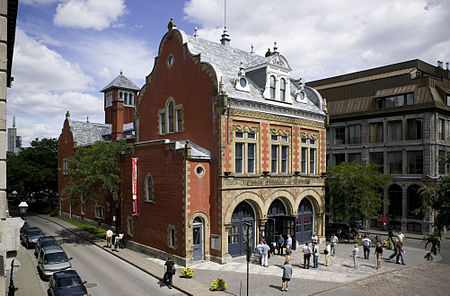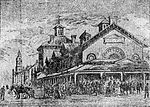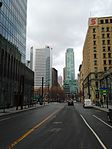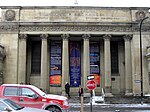The burning of the Parliament Buildings in Montreal was an important event in pre-Confederation Canadian history and occurred on the night of April 25, 1849, in Montreal, the then-capital of the Province of Canada. It is considered a crucial moment in the development of the Canadian democratic tradition, largely as a consequence of how the matter was dealt with by then co-prime ministers of the united Province of Canada, Sir Louis-Hippolyte Lafontaine and Robert Baldwin.
The St. Anne's Market building lodging the Legislative Council and Assembly of Canada was burned down by Tory rioters as a protest against the Rebellion Losses Bill while the members of the Legislative Assembly were sitting in session. There were protests right across British North America. The episode is characterized by divisions in pre-Confederation Canadian society concerning whether Canada was the North American appendage of the British Empire or a nascent sovereign nation.
In 1837 and 1838 Canada was hit by an economic depression caused partly by unusually bad weather and the banking crisis in the United States and Europe. A few Canadians in Upper and Lower Canada (now the Canadian provinces of Ontario and Quebec respectively) used the bad economic climate to demand political changes. The Rebellions of 1837 occurred first in Lower Canada, then in Upper Canada. After Lord Durham's Report political reforms followed the rebellions.
Many key leaders of the Rebellions would play focal roles in the development of the political and philosophical foundations for an independent Canada, something achieved on July 1, 1867. The Rebellion Losses Bill was intended to both offer amnesty to former rebels (permitting them to return to Canada) and an indemnity to individuals who had suffered financial losses as a consequence of the rebellions. In Upper Canada only those not convicted of Rebellion were compensated. Lord Durham had granted an amnesty to those involved in the first Rebellion but not to those in the Second Rebellion. The rioters wanted the compensation money to go only to loyalist French and English Canadians. The Rebellion Losses Bill diverted money away from just Loyalists but to many who had caused the Rebellion. The bill was passed by the majority of those sitting in the Legislative Assembly and remained unpopular with most of the population of Canada East and West whose tax money went to rebels. Those in Montreal decided to use violence to demonstrate their opposition. It is the only time in the history of the British Empire and Commonwealth that citizens burned down their Parliamentary Buildings in protest. The Parliament buildings were destroyed amidst considerable mob violence, and an invaluable collection of historical records kept in the parliamentary library was lost forever.
Despite the tense situation and deplorable socio-cultural crime committed by the mob, Lafontaine proceeded cautiously, fought off armed thugs who had shot through his window, and maintained restraint and resolve in his actions. Jailed members of the mob were released on bail soon after their arrest and a force of special constables established to keep the peace. Though there was public concern this might be a crushing blow to the reform movement, Lafontaine persevered despite the opposition, and would continue in his role developing the tenets of Canadian federalism – peace, order, and good government. Within a decade public opinion had shifted overwhelmingly in the development of a sovereign Canada.











